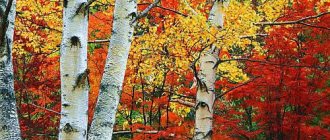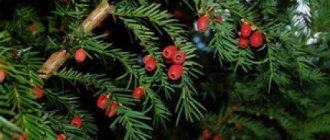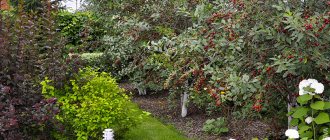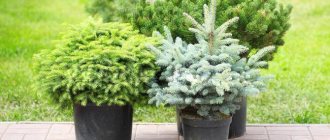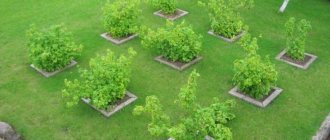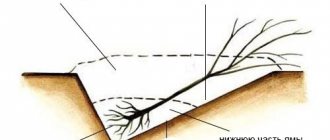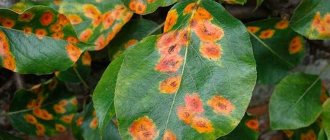What plants grow in the shade?
To arrange a shaded area of the garden, you need to know plants that love shade. Many gardeners are interested in whether there is a difference between shade-loving and shade-tolerant plants. There is no difference, we are talking about a group of plants that do not get enough direct sunlight, but scattered or reflected sunlight. Shade-tolerant plants for the garden are varied. It can be:
- shrubs;
- flowers;
- climbing plants;
- lawn;
- conifers;
- deciduous;
- fruit plants;
- trees.
Shade-tolerant flowers for the garden
When choosing shade-tolerant flowers for a flower bed, you should take a closer look at the most durable and beautiful options. In addition, it is important to know about flowering time in order to organize a flower garden that will be decorated with flowers from early spring to late autumn.
- Corydalis is hollow.It blooms in early spring, has interesting flowers, very unusual shapes.
- Parterre lawn. This look looks very impressive, but is expensive and requires careful and careful care.
- Rhododendron. Shade-tolerant heather plants for the garden will decorate any garden during the flowering period.
Shade-tolerant coniferous plants for the garden
When choosing shade-tolerant coniferous plant species, you need to decide on the height and care features. There are several low-growing coniferous representatives that you should pay special attention to, because these shade-tolerant garden plants from the order of conifers look very beautiful and unusual, especially if you choose a worthy company for them.
- Canadian hemlock. This plant does not tolerate heat well, so shade is a must for it. It is also important to provide the hemlock with good moisture. Davidia. Used for single landing. This tree looks beautiful thanks to its cream-colored bracts. Cherry. This tree grows in shaded areas and dense thickets, does not require special care and tolerates frost well. Blue spruce. This type of spruce loves both shade and partial shade. The soil needs to be dry, which makes this tree as unpretentious as possible.
Which fruit trees love shade?
Most fruit trees are light-loving. However, there are also those who feel quite normal in the shadows.
Let's call them:
- cherry - it can be planted in the most secluded places of the garden, because it tolerates shade and even denseness;
- cherry plum - although considered a southern tree, it is quite tolerant of the lack of direct light, unpretentious and productive;
- plum - blue varieties of plums are suitable for growing in partial shade, but yellow varieties suffer from lack of sun and therefore will not give a good harvest;
- apple tree - except for lowlands, it tolerates any planting site, including shady ones.
Trees growing in the shade
Even in a narrow shady strip between the house and the fence, you can plant such FRUIT trees as:
- Cherry - especially tall trees tolerate shade very well. It can grow in the most secluded places, and at the same time it will delight you with a bountiful harvest.
- Apple tree - can grow both in the sun and in the shade, its only enemy, which should be avoided, is the lowlands, where frosts can destroy the crop while the tree is flowering
What shrubs can be planted in the shade in the garden
The choice of shade-tolerant shrubs is more varied than that of fruit trees. However, you can’t leave them completely without lighting. So, with excessive shading, a crop such as raspberries weakens. As for currants, which are traditionally planted in the most inconvenient places, red currants tolerate shading worse than black currants. At the same time, when planting a red currant variety, you should take into account that good overhead lighting is a must, but it can cope better with the lack of side light.
The following perennial bushes can be planted in shaded areas at the dacha:
- currants of different varieties - red, black, white;
- blackberries;
- raspberries;
- black elderberry;
- common hazel;
- dogwood and male dogwood;
- viburnum;
- barberry;
- honeysuckle.
Important! Not all of them are equally easy to take root in serious shade. Most tolerate shading, but cannot tolerate a deep lack of sun.
Therefore, there is no need to specifically shade them. These fruits and berries do not exactly adore the shade, but are ready to endure it. In any case, berry bushes with sweet fruits ripen well only with sufficient lighting.
You can focus on how closely the selected shrub resembles its wild, forest comrades. It is garden plants that are characteristic of forest communities that grow easier than others and bear fruit well in shaded conditions. An example would be blackberries, alpine currants, varieties of barberry, and viburnum. Serviceberry and blue honeysuckle show themselves well - all those plants that in nature are accustomed to living and developing in the lowest tier of the forest. And the best representatives in terms of endurance are chokeberry, also known as chokeberry, and hazel.
What can you plant in the shade?
It is easiest to identify light-loving crops (of which there are an overwhelming number) on your acres of land. The problem arises with shady areas, where not all fruit trees and shrubs for the garden can grow. Besides, shadow is different!
You can try to plant light-loving fruit bushes for the garden in a shaded place, but the return from them compared to what is expected will be completely opposite, because the crops will only have to adapt to unfavorable conditions for themselves and simply try to survive in them, not to mention their high productivity.
Flowers growing in the shade
Under trees and between buildings, even in deep shade, it’s possible to create cute flowering flower beds. Flowers that are not afraid of shadow are suitable for this:
- Primrose . When growing garden primrose, the main thing is to choose the right place for planting. It should be planted in partial shade or in corners of the garden with diffused light, but, of course, where it will be properly ventilated. It will also like to grow under fruit or ornamental trees, or late leafing shrubs. Primrose grows low from 10 to 20 cm, blooms from April to May
- Hellebore . A perennial that loves to grow near other bushes and trees, feels great next to ferns, corydalis, crocuses, grows up to 40 cm, blooms immediately after the last frost and until the end of June
Shrubs in the shade as decorative garden elements
It is recommended to plant shade-loving fruit trees and shrubs for the garden in the shade. By the way, some of them, surprisingly, cannot stand the sun at all and can get burned from its rays.
Shade-loving fruit trees and shrubs for the garden will enliven shaded places with their foliage, and often attention is attracted not by their flowers, but by their leaves: original, varied, adding decorativeness to the overall appearance. Factors such as the varied shape of leaves (kidney-shaped, lobed, heart-shaped, lanceolate), their unusual texture (color shades, raised veins, pubescence) and even arrangement on the stem (alternately, not covering or shading each other) can create an attractive composition, from which you will subsequently be able to obtain an excellent, high-quality harvest.
Shade-tolerant and shade-loving - what are their differences?
We will talk about fruit trees and shrubs that grow well and bear fruit in the shade. Theoretically, any plant can be placed in the shade and it will be able to survive. But not everyone will be able to get a good and abundant harvest. After all, plants, like people, are different: some people can sunbathe in the sun, while others get too much of a tan in the shade of trees.
Fruit trees and shrubs in the shade
Before choosing which fruit trees and shrubs can be planted in the shade, it is recommended to find out which of them are shade-loving and which are shade-tolerant.
- Shade-loving plants are those that do not need rays of bright light; on the contrary, they need poorly lit places.
- Shade-tolerant plants are able to grow well where there is sun, but can also tolerate shade. At the same time, if shade-tolerant fruit trees are planted in a very dark place, they will not bear fruit, although they may bloom.
Shrub of Life - Honeysuckle
The very interpretation of the name of the culture (“life” and “youth”) indicates the enormous benefits of such a plant. The shrub, whose height can reach 2.5 meters, has yellowish-brown bark and pale green oblong leaves. Not all fruit bushes for the garden are characterized by such vitality; The age of honeysuckle in natural conditions can exceed a hundred years. This plant is simply recommended for growing in summer cottages due to its powerful anti-inflammatory characteristics, choleretic and diuretic effects, as well as the performance of protective functions, especially in cases of intoxication of the body. Interestingly, the first pruning of the plant is carried out 5-7 years after planting due to its too slow growth. With such a bush, a plot located in the shade can turn into a real berry conveyor belt, the main thing is to have time to harvest a bountiful harvest!
Shade-loving fruit bushes for the garden
Each summer resident tries to distribute all the plants on the site as efficiently as possible, but in any case, shaded areas remain. We will consider further what garden crops can be planted in poorly lit places.
Shaded areas
Most often, shade is formed under garden trees, and it is most practical to place fruit bushes there. If a building casts a shadow, then there will be much less light there than in the garden, which means it is not advisable to plant plants in such a place. The fact is that trees still transmit light through themselves, albeit in small quantities, and in the shade of a house it will be too difficult for plants, even shade-loving ones. There they will simply try to survive in the given conditions and will not be able to get a decent harvest from such bushes. In addition, trees can also create such a shadow if their plantings are too dense. Even light-loving plants can be planted in the shade of the garden, but the harvest from them should not be expected to be too large. The lack of light will affect the yield of the shrub, but in general the plants will be quite viable.
Garden decoration
Shade-loving fruit bushes for the garden should be planted only in the shade. The fact is that the leaves of such plants are too sensitive and can get burned from bright rays. Also, such plants can please their owner with the beautiful appearance of the shrub. As a rule, the foliage of shady plants is very diverse and original. They can become a full-fledged decoration of the site in the form of decorative elements. The leaves of such shrubs may differ not only in color, but also in shape or location on the branch. And by arranging such shrubs in an interesting order, you can create a complete composition that will attract the attention of all guests.
Shade-loving plants
As already mentioned, any plants can be planted in not too dense shade, but special shrubs will grow best. The list of shrubs with maximum productivity in dimly lit places is supplemented by currants of all colors, raspberries, blackberries, walnut bushes, black elderberry, dogwood, barberry, viburnum, and so on. Growing currants
This cultivated plant is best suited for growing in the shade of a garden. Of course, even currants will bear fruit best in illuminated areas, but in the absence of such, the partial shade of the garden will do. Currants reproduce very quickly and easily; their demands on the soil are not excessive. You can get large fruits from the pygmy, vigorous and mermaid varieties, while the shrubs are compact and high-yielding. The alpine variety is characterized by the high height of the bush, which can reach two meters. Its flowers are yellow and have original, beautiful leaves. The variety begins to bloom in May, and the first fruits can be tasted in July. The berries have a beautiful red color, but at the same time they have no pronounced taste. All varieties of this plant tolerate winter well, so they are excellent for the middle zone. During severe frosts, it does not need to be wrapped or covered.
Black elderberry as a protector
This plant can improve the health of not only its owner, but also the area itself. The plant repels pests well, and all its derivatives, including berries, leaves, flowers and bark, have healing properties. The fruits of elderberry are glossy black in color and can hang on the bush even after the leaves have fallen. The plant will not tolerate too dense shade, but in the shade of the garden it will grow well, and also protect the trees from diseases. With its appearance, elderberry will create a good composition on the site.
Honeysuckle source of life
There are many varieties of this shrub, from ornamental to fruit. It is the latter that will be discussed. The name itself carries information about the benefits of the plant, which can reach a height of more than 2 meters. Its foliage is pale in color, as is its bark, not very attractive at first glance. But it is interesting that in its natural environment this shrub can exist for more than a hundred years. Honeysuckle provides people with anti-inflammatory, diuretic and choleretic activity. It is also used for intoxication, improving the body's protective functions. The plant owes such a long period of life to its slow growth. Therefore, the first pruning is done no earlier than five years after planting, possibly even later. By planting honeysuckle in the shade, which is unsuitable for other plants, the summer resident will receive excellent returns with a huge harvest of fruits.
More health plants
Viburnum will have a huge healing effect on the body. In addition to useful berries, this plant can also please with its beauty. Unpicked fruits can survive on the branches until snowfalls and feed birds. Most rosehip varieties also grow successfully in the shade. Its delightful aroma will certainly attract a sufficient number of insects to the site that can pollinate the entire garden. The fruits have long been known for their medicinal properties.
And, of course, everyone’s favorite raspberries. All children and adults simply adore this berry, and the healing properties of raspberries have been known for centuries. When planting this plant in the shade, you should provide it with nutritious soil, as well as protect it from strong winds and provide it with moisture. When growing raspberries, its proximity is also important; for example, this shrub will grow very poorly under apple trees. The fact is that raspberries quickly spread their roots and leave no nutrients for the tree. The apple tree, in response, just when the bush is fruiting, unleashes all its parasites on it, which are impossible to fight due to the presence of berries on the bushes.
Hazel and dogwood
The walnut bush is gaining popularity every year and can grow up to five meters in height. Its flowering begins even before the leaves bloom and consists of purple earrings that adorn the bush. Unlike hazel, dogwood is less popular, but its properties are attractive enough to plant a shrub on your site. The bush may resemble a tree with a well-formed crown. The height of the shrub reaches two and a half meters and grows on not too dense and fertilized soils. Dogwood berries have a sour taste and their yield depends on the age of the plant. In the first ten years, dogwood is capable of producing twenty-five kilograms of berries per season, and then even more.
barberry bush
The plant has many varieties, but gardeners often find only dwarf bushes. They are more convenient during berry picking and can form a beautiful hedge. The bush feels good on neutral soil, grows and takes root quickly, so it often needs to be pruned. Raspberries can be a good neighbor for such a plant. Barberry tolerates cold well, and its berries are often used for industrial purposes.
More shade-loving shrubs
Gooseberries are capable of producing a good harvest in the shade. It is not picky about the soil, useful and tolerates cold well. Blackberries will also grow well in the shade.
Conclusion
When filling your plot with various plants, it is important to start not only from their agrotechnical properties. With the right choice of plants, in the autumn they will be able to please with the riot of colors of their attire and lift the spirits of all guests.
Shade plants for health
Viburnum is a beautiful shrub that is pleasant to admire at any time of the year. In summer, the plant pleases the eye with attractive spherical or umbrella-shaped inflorescences with pale pink or snow-white flowers. In autumn, the carved foliage sparkles admiration, playing with different shades of berries hanging on the branches: from juicy orange to rich crimson-red. Viburnum fruits can hang until the snow falls, being especially popular with birds during this period. The beneficial properties of this culture are successfully used in folk medicine. Fruit bushes for the garden, in particular viburnum, will only decorate the summer cottage, giving it a touch of aristocratic nobility and ornamental beauty.
Rosehip (most varieties) is also a shade-loving plant. In the summer, it will delight you with fragrant bright flowers and a swarm of bumblebees useful for the garden; in the fall, the plant will produce a wonderful harvest of healthy berries, which, when dried, will become a medicinal basis for many medicinal compositions.
Raspberries are tasty and aromatic, a favorite berry of adults and children, the benefits of which are known to everyone. Being a shade-tolerant plant, it is very demanding of the soil in which it grows. The area allocated for its planting should be moderately moist and protected from piercing winds. The varieties most adapted for growing in the shade are Turner, Marlboro, Crimson Mammut. The compatibility of fruit trees and shrubs in the garden should be taken into account when planting raspberries and apple trees nearby. This neighborhood is unprofitable for both. The fast-growing root system of raspberries, located close to the surface, takes all nutrients from the soil, thereby dooming its fruit neighbor to a hungry existence. The apple tree, in turn, during the period of active development, which coincides with the flowering and fruiting of raspberries, generously shares with the latter the pests present on it, the destruction of which by spraying will cause poisons to reach the ripe raspberries.
Dogwood and hazel: useful and beautiful
Dogwood is a less common crop, but this in no way detracts from its medicinal and technical properties. Representing a bush or tree, the height of which is about 2.5 meters, it has a well-leafed, compact crown, giving the area in which it grows a neat and well-groomed appearance. The taste of juicy aromatic fruits is sweet, with some pleasant sourness. The plant is not picky about soils, but it bears fruit optimally on well-fertilized light soils. Productivity increases progressively: at the age of 5-10 years the plant can produce up to 25 kg of fruits, at 15-20 years - from 40 to 60 kg, at 25-40 years - up to 100 kg of beautiful high-quality berries.
Common hazel, which is becoming increasingly popular among gardeners due to its tasty fruits, tolerates shade well and grows up to 5 meters in height. Blooming early, before the leaves bloom, it forms graceful earrings at the ends of the shoots, when you look at them, your mood rises in anticipation of the onset of long-awaited warm days.
